| Mike Rowe had started his day’s sailing
long before the sea-breeze set in, but he needed an
early start to get through the long channel while
there was still a favourable tide flowing. He always
found that his sailing adventures were more satisfying
if he could complete a round trip without ever using
an auxiliary motor – even for entering and leaving
port. This meant that his schedule was controlled
by the tide and wind – not the clock. He also
liked the feeling of moral superiority when the day’s
run was over and he hadn’t used an engine.
Leaving the boat ramp area had required an interesting
beat hard on the wind. Mike was grateful that the
lapstrake (clinker) sailing dinghy had plenty of sail
area, because the wind was light and flukey. Every
square inch of sail was needed for the boat to keep
moving efficiently as he tacked and tacked his way
around protruding rocks, mud-banks and seagrass-covered
sandbars. The game of climbing up against the wind
to get around obstacles was one that Mike enjoyed
tremendously, and was just one of the reasons that
he found small-boat sailing so enjoyable.
In the days when working boats relied on sails and
oars for propulsion, sail-plans were much larger than
are normally seen today. The working sailor expected
to have to tie in reefs as the wind piped up. Today’s
sailor seems more likely to have a smaller sail-plan,
making use of auxiliary engines in light conditions.
While this approach is certainly practical, it means
that the skill of reefing is seldom learned.
Playing the wind-shifts, and maximizing every opportunity
to gain distance into the wind was great fun to Mike
on that morning, but if the boat hadn’t carried
lots of sail, it might well have been a frustrating
experience. The joy of ‘spirited’ sailing
is more about relative performance than about absolute
speed. Mike was quite happy to reef later on when
the wind increased, but right now he thanked the designer
for putting large sails on his boat.
Rounding the southern headland, Mike was able to
ease sheets, and take up an easy reach down the wide
waterway between the mainland and the barrier island
over on the port beam. Both sails were pulling gently
in the light wind, but because of the boat being on
a reach, their action was efficient and the boat easily
came up to her hull-speed. With nothing to do for
the next hour or so, Mike was able to sit in a comfortable
position on the bottom of the boat with his shoulder
blades well supported by the side decks. Life felt
pretty good!
It is such a pity that small-boat sailors have generally
not learnt the skill of reefing. Frequently it is
possible to see people struggling to hold a boat up,
and on course, when it is obvious to an experienced
eye that the boat is over-canvassed for the prevailing
conditions. Many people don’t understand that
a boat will often go faster after having a reef tied
in, while at the same time the strain is taken off
the crew. If you want to explore the physics of this
fact, have a read of Frank Bethwaite’s wonderful
book, ‘High
Performance Sailing’. Mike
well remembered a day (long ago) when he and a friend
were sailing a heavily-reefed dinghy when 35 knot
winds had sent every other sailing boat home. Their
boat was reduced to about half of her normal sail
area, but Mike and his friend were comfortably seated
on the weather rail eating salted peanuts while the
boat sailed efficiently and in a docile manner. They
were having a great sail at a time when everybody
else had gone home…
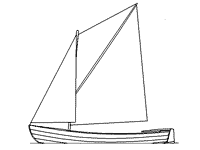 |
Full Sail –
104 sq.ft.
(click images
to enlarge) |
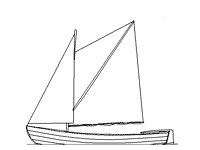 |
Full Jib –
Reefed Main – 86 sq.ft. |
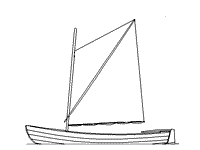 |
Reefed Main
Only – 64 sq.ft. |
The big boat sailors still reef routinely, but not
many dinghy sailors follow their example. Do yourself
a favour and learn the skill – you will enjoy
your sailing more, and go much further in safety.
Seaworthiness is more about judgment and skill on
the part of the skipper, than about the shape and
size of the boat.
In case you want to know, Mike had a great day sailing,
and ended up getting home in the late afternoon with
a deep reef tied into his mainsail, and with the jib
stowed away in the forward compartment. I’d
tell you the whole story, but I haven’t got
enough time – you’ll just have to go out
and try it for yourself…
Additional Rigs For Phoenix III
I’ve been approached by a customer who would
like the option of two additional rigs for my design,
Phoenix III: -
• A Bermudian Sloop for two-up sailing in local
mixed-fleet racing; and
• A Balanced Lug of modest area for gentle sailing,
or for teaching novices and those of nervous disposition.
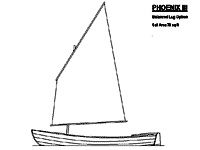 |
Balanced Lug
Option – 76 sq.ft. |
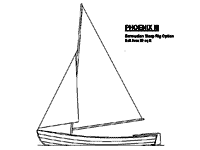 |
Bermudian Sloop
Option – 89 sq.ft. |
I am not particularly enthusiastic about the Bermudian
Sloop option, because it complicates the boat considerably
– forestay, shrouds, chainplates, and (maybe)
spreaders – and a very long mast.
But, the Balanced Lug strikes me as being an excellent
rig for the boat, and it is definitely more simple
to set-up than the existing Sprit-Sloop. Despite its
reduced sail area compared with the Sprit-Sloop, it
will still drive the boat in a spirited manner.
My existing boat (a larger boat than Phoenix III)
has been rigged in many different ways, but her current
rig is a Balanced Lug. I like it very much.
O.K., so why didn’t I specify a Balance Lug
in the first place? Well, I wanted the boat to go
as fast as possible when hard on the wind, and I wanted
the maximum sail area from the shortest spars and
the lowest rig.
The Sprit-Sloop is one of the few rigs which can
fly a jib effectively without having to use shrouds
or backstays of any sort. It also allows the shortest
mast for a given sail area. My own Phoenix III will
have the Sprit-Sloop rig, but I will also have a Balanced
Lug rig for those occasions when I feel like a less
strenuous sailing session.
The two additional rigs have been designed to use
the existing mast step and mast partner, so no changes
are required to the structure of the boat (the Bermudian
will require stays).
In the case of the Balanced Lug rig, not only are
the mast step and mast partner unchanged, but it uses
the same mast as for the standard rig.
Both of the additional rigs are available as supplements,
and include the sail plan, spar plans, and rigging
details.

More columns by Ross Lillistone
|